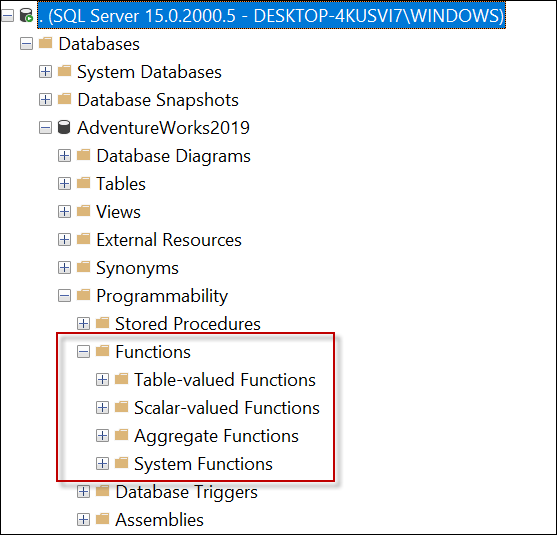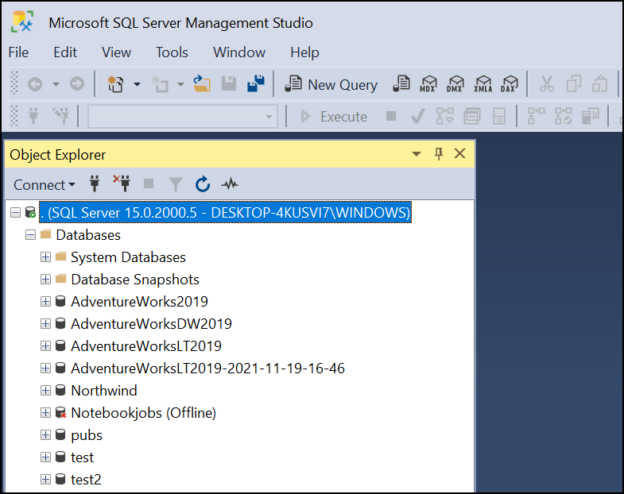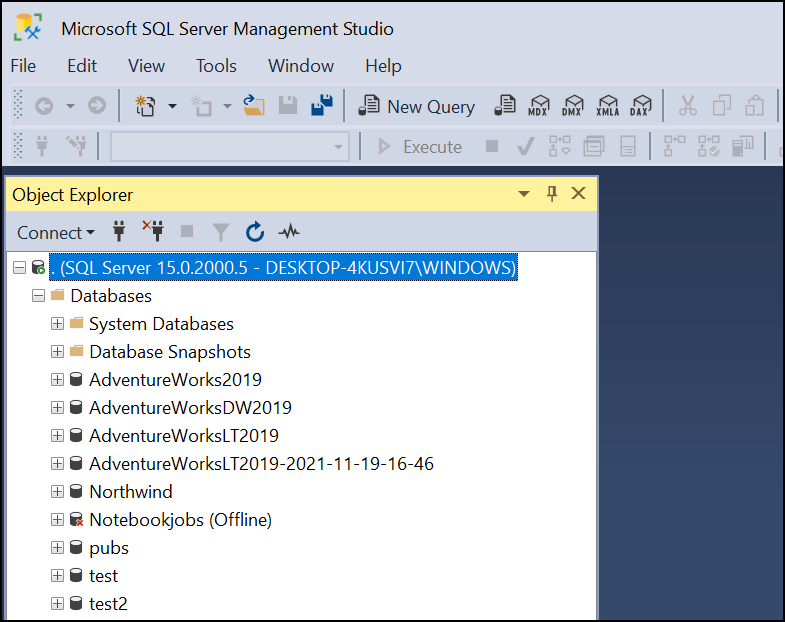This article is a SQL Server Tutorial. If you want to learn how to install and start with SQL Server from 0, this is the place to start. We will teach you to install SQL Server, start your first queries, and explain the basics to start with SQL Server Integration Services (SSIS), SQL Server Reporting Services (SSRS), SQL Server Analysis Services (SSAS), Data Quality Services (DQS), Master Data Services (MDS) and Azure and more.
How to install SQL Server
There are many installers, versions, and editions. We will explain first what are the editions and then we will talk about the different versions.
SQL Server edition
You have SQL Server Enterprise, Standard, Web, Developer, and Express editions.
The developer edition is a free edition for developers. It includes all the features. The Express edition is free and very limited but can be used in production.
The enterprise edition is a paid full version of SQL Server. The Standard edition has some limitations like the Online index creation and rebuild. For more information about the SQL Server editions, please refer to this link:
To install SQL Server on different editions, follow these links:
SQL Server versions
You have SQL Server versions 2014, 2016, and 2017 and as of the time of writing this article, the last official version is 2019. The 2022 version is on the preview version.
To learn, we recommend using the last official 2019 version. However, the main features are similar in all of these versions. If you want to learn the new features in SQL Server 2019, you can read the article below:
To install in earlier versions, refer to these links:
SQL Server Tutorial to learn for Linux
SQL Server is from Microsoft, then Windows is the favorite operating system. However, there is a version in Linux. If you like Linux, you may also be interested in the SQL Server version for Linux, if that is your case, here we have some nice articles that we wrote for you:
- How to install SQL Server on Ubuntu
- How to install SQL Server 2019 on RedHat Linux 18
- How to install SQL Server on Linux hosted on Windows Server 2019
- Install SQL Server Linux (2017 version) on SUSE Linux in the Amazon EC2 instance
SQL Server Tutorial to Install SSMS
Once you installed the SQL Server, you need to install SQL Server Management Studio (SSMS). You could also use Azure Data Studio or Visual Studio, but SSMS is recommended because the other ones have some functionality limitations.
In order to install SSMS, please refer to the following article:
SQL Server Tutorial to install the Adventureworks database
Once you have SQL Server installed and SSMS installed, you need to install the AdventureWorks database. It is not mandatory but strongly recommended if you are learning because you will not need to create tables from scratch. You will be able to use this sample database and check tables, stored procedures, functions, and more.
To install and configure the Adventureworks database, please follow this link:
SQL Server Tutorial to learn your first queries
The basis in databases is to learn SQL and then T-SQL. SQL (Structured Query Language) is a standardized programming language to query and manipulate databases. T-SQL is an extension of SQL used in SQL Server.
To start your first queries, you need to learn how to query tables. You will learn how to get data from the tables. The tables are basically a collection of related data which contains columns and rows.
To learn how to query data in SQL Server, please refer to this article:
SQL Server Tutorial to learn the Data Definition Language (DDL)
DDL is the language to create, drop, and alter database objects. For example, if you need to create a table, you will use the create table statement. For more information about DDL, please refer to this link:
SQL Server Tutorial to learn the Data Manipulation Language (DML)
DML is used to insert, delete and update data.
For example, you have a table with customers. If you want to add a new customer you will insert a new row with the customer data of the new customer. If you want to delete a customer, you will use the delete command and finally, if you need to update information like a new phone number, you will use the update statement. For more information about the DML, please refer to these links:
- SQL commands in SQL Server
- Learn SQL: INSERT INTO TABLE
- Getting started with the SQL UPDATE syntax
- Overview of the SQL Delete statement
Create tables using the UI
If you do not like programming, you could use the UI in SSMS. The following article shows how to use SSMS to create SQL Server tables.
The following article will show you how to create tables in SSMS:
SQL Server Tutorial to create stored procedures
You can also create your stored procedures. In SQL Server, the stored procedures are more popular than the functions. They are more flexible to program whatever you want. The following tutorial will teach you how to create your stored procedures from scratch.
SQL Server functions

The functions are also very important to handle the data. You have scalar functions that return a single value, inline tables-valued functions that return tables, and multi-statement table-value functions that return a table and the structure of this table can be created by the user.
For more information about these functions, refer to these links:
- How to use SQL Server built-in functions and create user-defined scalar functions
- Improvements of Scalar User-defined function performance in SQL Server 2019
- SQL Server inline table-valued functions
- SQL Server multi-statement table-valued functions
SQL Server Tutorial to learn SSIS, SSAS, and SSRS
SSIS, SSAS, and SSRS are Business Intelligence tools used to integrate information, create Multidimensional and Tabular models, and finally create reports. The following links provide information about them:
- Implementing an SSAS Tabular Model for Data Analytics
- How to build a cube from scratch using SQL Server Analysis Services (SSAS)
- Lesson 1: Create a project and basic package with SSIS
- Create a Basic Table Report (SSRS Tutorial)
SQL Server Tutorial for Data Quality Services
Data Quality Services are used to correct, enrich, standardize, and de-duplicate data.
The following articles will help you to learn more about DQS:
- Data Quality Services
- How to clean data using Data Quality Services and SQL Server Integration Services
- How to clean Master Data Services data using Data Quality Services in SQL Server
SQL Server Tutorial for MDS
MDS allows handling the master set of your company’s data. You can organize your information using this service.
For more information about the MDS, refer to this link:
SQL Server Tutorial for Azure
Finally, we have Azure SQL, SQL Server in virtual machines, Azure SQL Managed instances, and Synapse.
Azure SQL is a service of a SQL database in the Microsoft cloud (Azure). The SQL Server in a Virtual Machine in Azure is basically SQL Server installed in a machine in the Microsoft cloud. Finally, the Azure SQL Managed Instance is a virtual SQL Server instance in Azure. Finally, Synapse is a limitless analytics service used for big data and data warehouses. It is a very powerful tool.
For more information about these services, please refer to these links:
- Getting started with Azure SQL
- Azure SQL – a FAQ article
- Azure SQL Interview Questions and Answers
- Azure SQL Managed Instance
- Migrating SQL workloads to Microsoft Azure: Databases trip to Azure SQL Database Managed Instance
- Azure SQL Database vs SQL Server on Azure Virtual Machines
- How to migrate your database to an Azure Virtual Machine
- Introduction to Azure Synapse Lake Database in Azure Synapse Analytics
Conclusion
In this article, we included a tutorial to learn SQL Server from 0. We started from scratch and then we showed some BI tools and other services. Finally, we talked about Azure which is the Microsoft cloud.
- PostgreSQL tutorial to create a user - November 12, 2023
- PostgreSQL Tutorial for beginners - April 6, 2023
- PSQL stored procedures overview and examples - February 14, 2023





